(222934 products available)


















































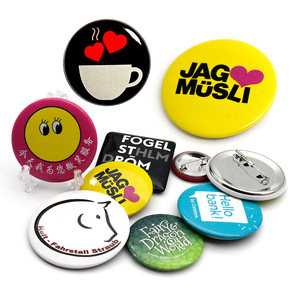
































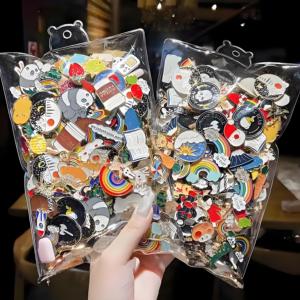

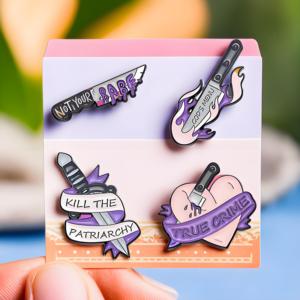





























































































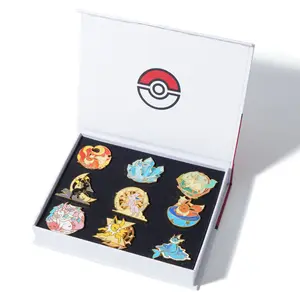






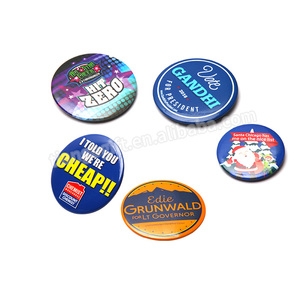
















Custom badges are images or symbols that are developed to identify a person’s affiliation with a certain organization, event, or group. They are normally pinned or attached to the clothing and are mostly produced in unique shapes or designs. Here are some types of custom badges.
Enamel Badges
Enamel badges are preferred for their refined and vivid appearance. They are developed by filling the recessed areas of a metal badge with colored enamel. This procedure produces a hard and smooth coating that is both polished and resilient. Custom enamel badges are generally used for commemorating achievements or as membership symbols for organizations and clubs. They are also used to market a corporation's logo since they are both classy and durable.
Printed Badges
Printed badges or buttons are developed by printing a design directly onto a badge or button using a printer or a press. This procedure allows for the use of vibrant colors and intricate designs, including images and photographs. Personalized printed badges are popular for events, promotions, or as a form of artistic expression. They are usually pinned onto clothing and are developed in various sizes and shapes.
Embossed Badges
Raised designs characterize embossed badges, which are typically crafted from metal. The design is stamped into the badge material, creating a three-dimensional effect. Personalized embossed badges are popular for corporate branding, as they create a tactile and visually striking representation of a logo or symbol. They are durable and have a metallic finish that is appealing.
Fabric Badges
Fabric badges are adaptable and can be developed through weaving or embroidery. These badges are usually made with threads of various colors to create a design that is both soft and flexible. They are commonly utilized by military organizations, sports teams, and for special events. Custom fabric badges have the ability to be washed and are comfortable to wear. They can be easily sewn or ironed onto garments.
Photo Badges
These badges incorporate photographs or images into their design, providing a realistic representation of the subject. They are usually developed using a combination of printing and doming techniques, which involve applying a clear, dome-like resin over the printed image. This procedure produces a vivid and protected image that is both striking and long-lasting. Personalized photo badges are popular for identifying individuals in events, such as conferences or festivals. They are also used for commemorating special occasions like weddings or anniversaries.
There are many different designs for custom badges, and each one is intended for a specific purpose. Below are some key design elements to consider when developing a custom badge.
Shape and Size
The badge's purpose will inform its shape and size. Rectangular designs are popular as they easily accommodate text and logos. Round badges are often used for achievements as they symbolize unity and completeness. Shield shapes are associated with security and authority. Custom shapes can provide a unique identity.
Material and Texture
Badges can be made from metal, plastic, fabric, or wood. Metal badges are durable and offer a premium feel. Plastic badges are lightweight and cost-effective. Fabric badges are flexible and easy to sew on. Wood badges provide an eco-friendly option. Each material offers a different texture that can enhance the badge's visual and tactile appeal.
Color Scheme
Colors evoke emotions and convey messages. Blue badges can symbolize trust and professionalism. Red badges attract attention and inspire action. Green badges often represent growth and harmony. The color scheme should align with the brand's identity and the message the badge conveys. Badges with enamel can appear more vibrant and are more resilient than those with paint.
Typography
Font style, size, and placement contribute to the badge's readability and aesthetic appeal. Bold fonts can emphasize important text. Script fonts can add a touch of elegance. The font should be legible and align with the badge's overall design theme. The badge's text can be embossed or debossed to give it a three-dimensional look.
Imagery and Symbols
Logos, icons, and patterns enhance the badge's meaning. Badges designed for organizations often incorporate their logos. Icons can represent specific achievements or roles. Patterns can add depth and complexity to the design. These elements should be clear and relevant to the badge's purpose.
Special Features
Custom badges may incorporate special features such as holographic elements, LED lights, or interchangeable parts. Holograms can add a layer of security and uniqueness. LED lights can make the badge more noticeable in low-light conditions. Interchangeable parts allow for customization based on different events or achievements.
Finish and Finish Options
The finish can affect the badge's appearance and feel. Polished finishes offer a shiny and reflective surface, while matte finishes provide a smooth and non-reflective look. Antique finishes can give the badge a vintage appearance. Each finish option can convey a different style and aesthetic.
These are some tips on how to wear and combine the badges with uniforms and other custom items.
Putting on the Badge
Put the badge on the left side of the chest, above the pocket. It should be flat and straight. For police uniforms, place it on the shoulder or sleeve. Make sure it is visible and neat. The same goes for scout badges; they should be on the uniform's chest. Badges of honor should sit over the heart. They must be secure and well-pressed. Check the badge's position before an event. It shows respect and pride in one's group. A proper badge placement can enhance the entire outfit. It draws attention to the badge's role and meaning. A good badge placement can boost confidence.
Matching the Badge to the Uniform
The badge should match the uniform's color. Choose a badge with a clear background. The uniform's color should not conceal the badge. For a navy blue uniform, select a badge with a white border. This creates a sharp contrast. The badge's design should suit the uniform's style. A formal uniform needs a formal badge design. Simple and elegant designs work well. They do not clash with the uniform's look. The badge should complement the uniform. It should not dominate the uniform. The badge and uniform should work together. They should create a cohesive appearance. The badge should enhance the uniform's design.
Combining Badges with Other Custom Items
Place badges on the left side of jackets. Align them with the shoulder seam. Space them evenly on the jacket. Avoid cluttering the jacket with too many badges. Select a few to represent key achievements. The badges should tell a story. They should reflect personal or group milestones. Choose badges that contrast well with the jacket's color. A dark jacket suits bright badge backgrounds. The badge design should complement the jacket's style. If the jacket has a formal look, select formal badge designs. They should blend with the jacket to create a unified look. This approach ensures a balanced and harmonious appearance, allowing each badge to stand out while contributing to the overall aesthetic of the custom jacket.
Q1: Is it possible to create a custom badge with a logo and text?
A1: Yes. It is possible to create a badge that incorporates both the logo and the text. This is a common requirement for many organizations and companies that need to include their logo and the specific text for identification or branding purposes. When placing the order, provide the logo and text and specify the design requirements. The badge producers will usually work with the customers to ensure the logo and text are clear and fit the badge size and design.
Q2: What are the file requirements for custom badge design?
A2: The file requirements may vary depending on the badge production method. Generally, high-resolution files are preferred. For digital designs, files like PNG or JPEG are usually acceptable. If the badge is to be produced using a laser engraving method, vector files like AI or EPS are preferred because they allow for scaling without loss of quality. Always check with the badge producer for their specific file requirements.
Q3: How are custom military badges made?
A3: Custom military badges are made through a process that starts with the design. This is followed by creating a prototype, which may be done using digital printing or soft enamel methods. Once approved, the badges are mass-produced using stamping or casting methods. The final steps include finishing, quality control, and packaging.
Q4: What materials are used to make custom name badges?
A4: Custom name badges are made using several materials. Plastic badges are lightweight and cost-effective. Metal badges, which are more durable, can be made from brass, aluminum, or stainless steel and are often preferred for their professional appearance. Magnetic backing is popular for its ease of use and to avoid damaging clothing.
Q5: How are custom badges attached to clothing?
A5: Custom badges are attached to clothing using several methods. Sewn-on badges are permanent and secure. Pin-back badges are easily removable and adjustable. Magnetic badges offer a no-damage alternative, while iron-on badges provide a fast and simple application method.